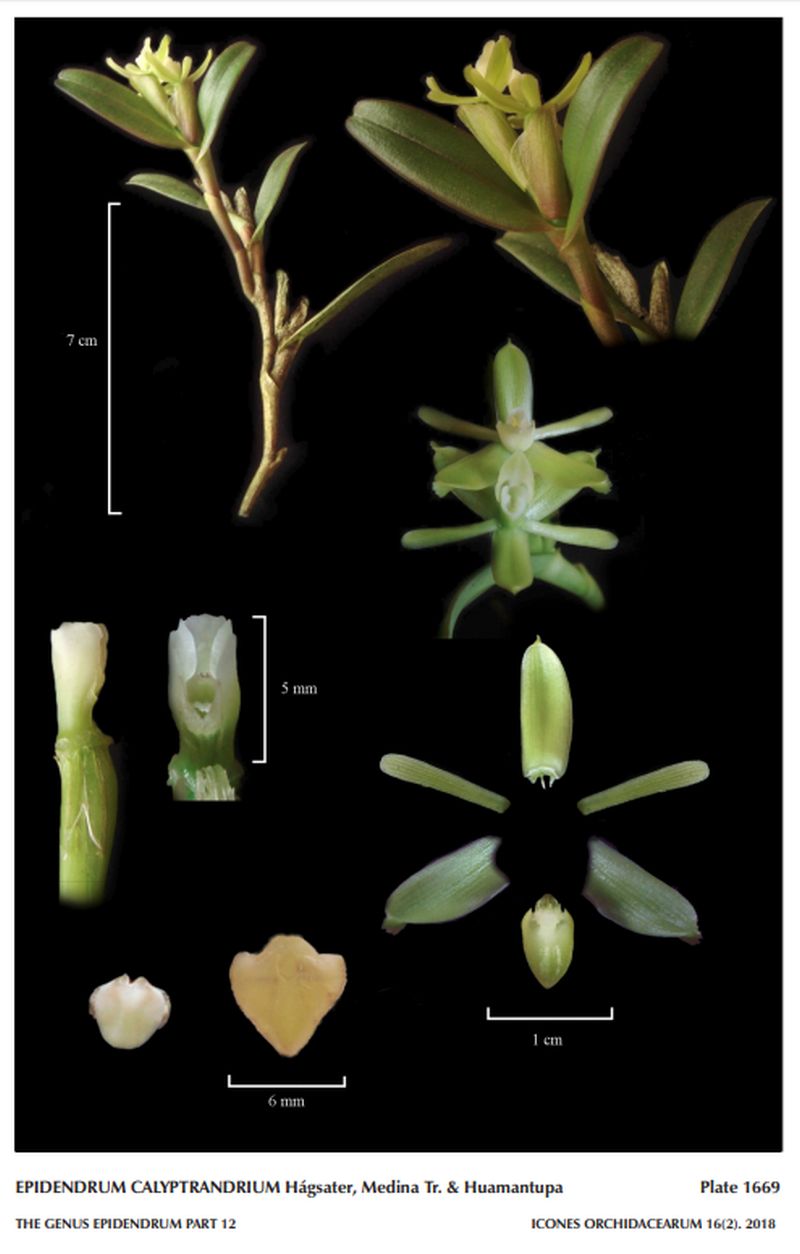

Epidendrum calyptrandrium Hágsater, Medina Tr. & Huamantupa 2018 GROUP Ramosum SUBGROUP Ramosum
LCDP Photo by R. Medina T. & C. Álvarez/TYPE Photo © by J. D. Edquén O. and The AMO Herbario Website


 LATER
LATER
Common Name The Mens Veil Epidendrum [In reference to the prominent, membranous, thin, clinandrium-hood, which is veil-like and surpasses the body of the column and continued down, to the sides of the column, which is characteristic of this species]
Flower Size 1.2" [3 cm]
Found in Colombia, Ecuador and Peru, widely distributed along the eastern slope of the Andes from southern Colombia to southern Peru in wet montane forest at elevations of 500 to 1900 meters as a large sized, warm to cool growing epiphyte with the primary stem 6 to 14" x .12" [15 to 35 x 0.3 cm], thereafter producing short, successive secondary stems from sub-apical internodes in succession from the 2nd or 3rd internode of the previous stem, forming long sub-erect chains, each stem 1.6 to 4.8" x .12 to .16" [4.0 to 12.0 x 0.3 to 0.4 cm], progressively shorter, terete, somewhat sinuous; the basal half covered by 2 non-foliar, terete, apex obtuse, somewhat keeled towards the apex, green, the base more or less tinged red-brown, turning light brown when dry, striated sheaths snd carrying 11 on primary stem, on secondary stems 2 to 3 per stem, aggregate towards the apex of stem, distichous, articulate; provided with a basal, tubular, somewhat conical, green tinged red-brown leaf sheath; blade oblong-elliptic, coriaceous, apex widely bilobed, margin entire, surface rugose, green, the margin red-brown leaves that blooms in the spring and summer on a terminal, without a spathe, from the mature stem, both primary and secondary, flowering only once, distichous, sub-sessile, rachis very short ca. .4" [1 cm] long, zig-zag, successivley 2 to 4, opening in succession, eventually all open at once inflorescence with covering the whole ovary, embracing, somewhat funnel-shaped in natural position, apex widely obtuse, green, tinged red-brown floral bracts and carrying green flowers with fragrance not registered, the lip cream to pale green, column and callus white. .
"Epidendrum calyptrandrium belongs to the GROUP Ramossum SUBGROUP Ramosum Characterized by the monopodial, branching stems the spike-like, distichous inflorescence, and the single callus. The species is distinguished by the branched, repent habit, main stem with shorter lateral branches, few-flowered distichous inflorescence, with large bracts covering the ovaries, the lip ovate-triangular, without obvious lateral lobes, and a single “Y” shaped callus forming a platform at the base of the lip. The species is recognized by the leaves 1.12 to 2.32" x .2 to .64" [2.8 to 5.8 x 0.5 to 1.6 cm] , oblong-elliptic, coriaceous, apex widely bilobed; flowers bright green, column and lip white, lip .24 x .24 [6 x 6 mm] when spread, triangular-ovate, and the column .2" [5 mm] long, with a prominent clinandrium-hood membranous, thin, surpassing the body of the column and nearly continued down to the sides of the column. Epidendrum ramosum is vegetatively very similar, as well as in the size of flowers which are olive green, lip is smaller, .26 x .18" [6.5 x 4.5 mm], and narrower than wide and flat, does not embrace the column. Epidendrum paradisicolum Hágsater & García-Cruz has leaves short and narrow .8 to 1.8" x .16 to .36" [2.0 to 4.5 x 0.4 to 0.9 cm], 2 to 3 flowered distichous inflorescence, the flowers green, small, sepals .26 to .3" [6.5 to 7.5 mm] long, cordiform lip, and short clinandrium. Epidendrum stevensii Hágsater is distinguished by its larger plants, leaves 1.6 to 2.8" [4 to 7 cm] long, ovary which forms an elongate vesicle, flowers are green, sepals .28 to .36" [7 to 9 mm] long, triangular-cordate lip, and reduced clinandrium. Epidendrum flexicaule Schltr. also has numerous leaves 1.2 to 3.2" [3 to 8 cm] long, the ovary which forms a short vesicle, flowers are green, turning orange-brown, the perianth segments .36 to .48" [9 to 12 mm] long, petals .08" [2 mm] wide, ovate-cordiform lip is longer than wide and flat, the apex rounded, and reduced clinandrium." Hagsater etal 2018
Synonyms
References W3 Tropicos, Kew Monocot list , IPNI ; *Icones Orchidacearum 16[2] Plate 1669 Hagsater & Sanchez 2018 drawing/photo fide;
----------------------------------------------------------------------------------------------------------